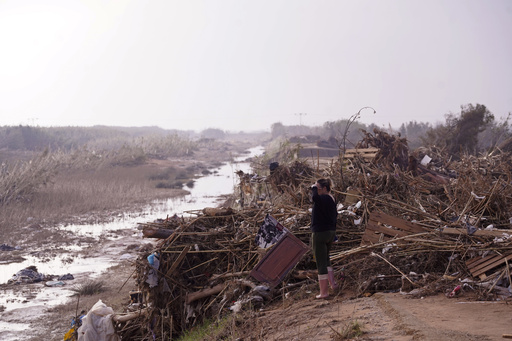
PAIPORTA, Spain — The scene of devastation in Paiporta is starkly evident with a mangled vehicle marking the tragic end for Jorge Tarazona’s three-year-old niece and sister-in-law, who lost their lives during the catastrophic flooding that swept through Spain last week. The car teeters precariously on the brink of a highway, a haunting reminder of the chaos that unfolded. According to Tarazona, his brother survived by clinging desperately to a fence after being swept away by a sudden and powerful wave that overflowed from a nearby drainage canal, leaving little time for escape as the family was trapped in traffic.
“They had no chance to react,” he recounted, visibly shaken. He explained how, in the midst of the turmoil, his brother was torn from the vehicle while his sister-in-law and niece were unable to escape. “She was able to send me their location, hoping for a rescue. The next day she was found dead inside,” he said, his voice breaking with emotion. The aftermath of the floods, which occurred on October 29, has left a grim toll, with at least 217 confirmed deceased and 89 others still unaccounted for, although this number may be underestimated.
The devastation in Paiporta, dubbed the “ground zero” of this natural disaster by local media, saw over 60 fatalities as torrents rushed from the Poyo canal. Frustration boiled over when residents welcomed the arrival of Spanish royals and officials with protestations, hurling mud and other objects amidst their despair. Prime Minister Pedro Sánchez’s visit was abruptly cut short as chaos ensued among the distraught locals. Meanwhile, the Civil Guard managed to rescue a couple trapped within their Paiporta home, a rare success in the wake of widespread destruction.
In response to the crisis, the mayor of Paiporta, Maribel Albalat, has called for external assistance, stating that the local administration is overwhelmed. She lamented the extensive damage wrought on municipal buildings, leading to civil servants being left in a “state of shock.” The mayor emphasized that while the community is resilient, the flooding has pushed their capabilities to the brink. The relentless sound of Chinook helicopters overhead and the activity of military personnel only heighten the sense of despair in the area.
The disaster’s impact extends well beyond Paiporta, affecting a vast region along the southern outskirts of Valencia city, resulting in casualties across seventy-eight localities. Authorities have broadened their search operations, scouring nearby marshes and the coast where victims may have been carried away by the currents. In the wake of the tragedy, residents and local governments can apply for help from a significant financial relief package totaling 10.6 billion euros provided by the Spanish government. However, the regional government of Valencia has criticized itself for not issuing timely warnings and requested additional funds amounting to 31 billion euros from Madrid to aid recovery efforts.
Days later, efforts to clear the debris continue, as the streets remain clogged with a thick layer of mud, and countless homes have suffered damage in kitchens and living spaces. The local business landscape has been devastated, leaving neighborhoods bereft of essential services and many homes are still without running water. An army of dedicated volunteers has mobilized to assist with the cleanup, working tirelessly to lift the muck and clear the debris that obstructed access to residences and vehicles. Authorities have dispatched 15,000 soldiers and law enforcement personnel to aid firefighters in their grim task of locating victims and clearing wrecked vehicles littering the region. The extensive damage is evident everywhere with cars toppled, smashed into buildings, and piled upon one another.
“There is still so much work to be done,” remarked volunteer Juanma Baztan López, who is currently assisting in the cleanup efforts in Catarroja, a town neighboring Paiporta. He has been instrumental in transporting medical professionals to those in need and supplying essential items while removing damaged cars from the streets. “It’s going to take a year to return to normal,” he predicted, outlining the long road ahead for this community.
